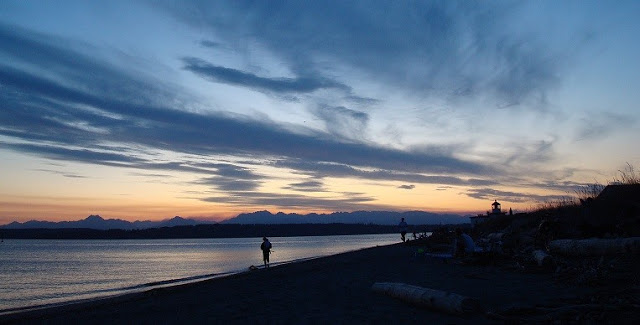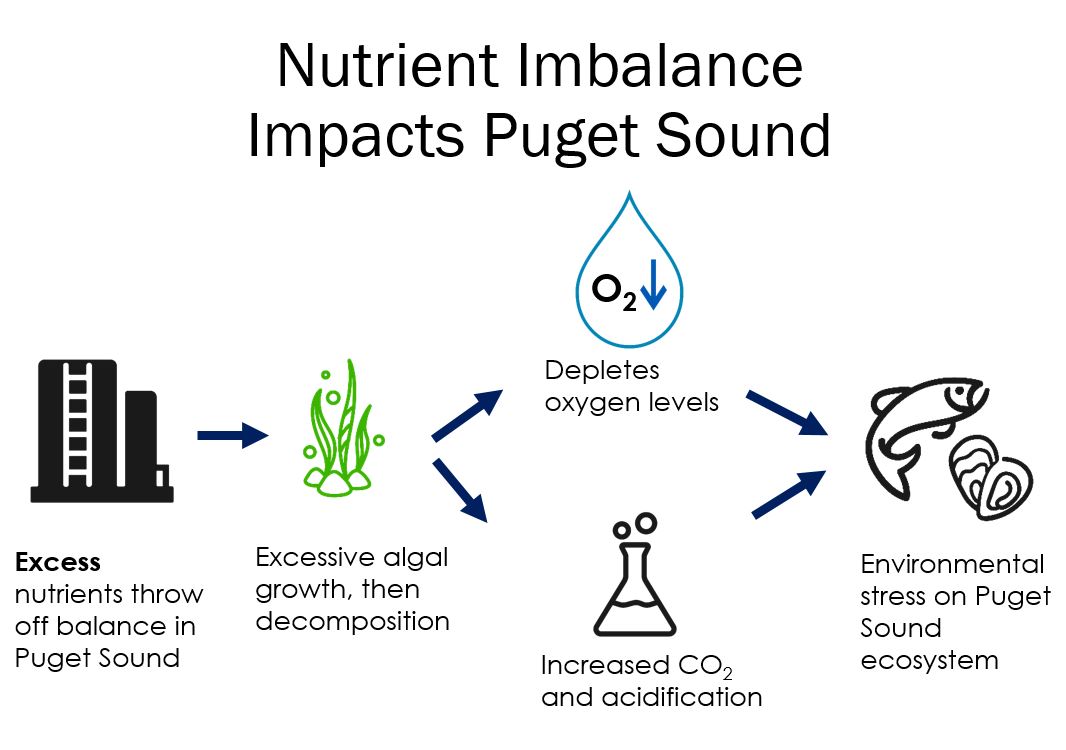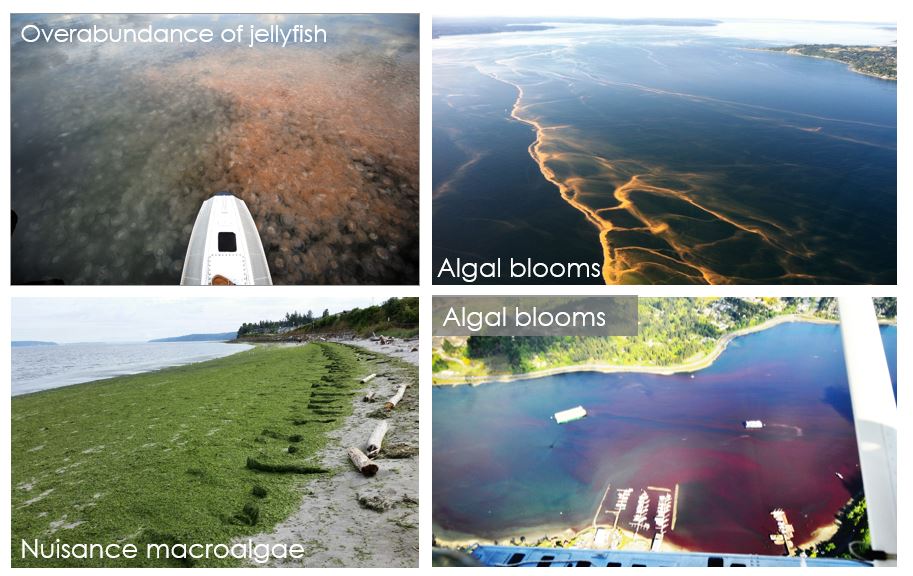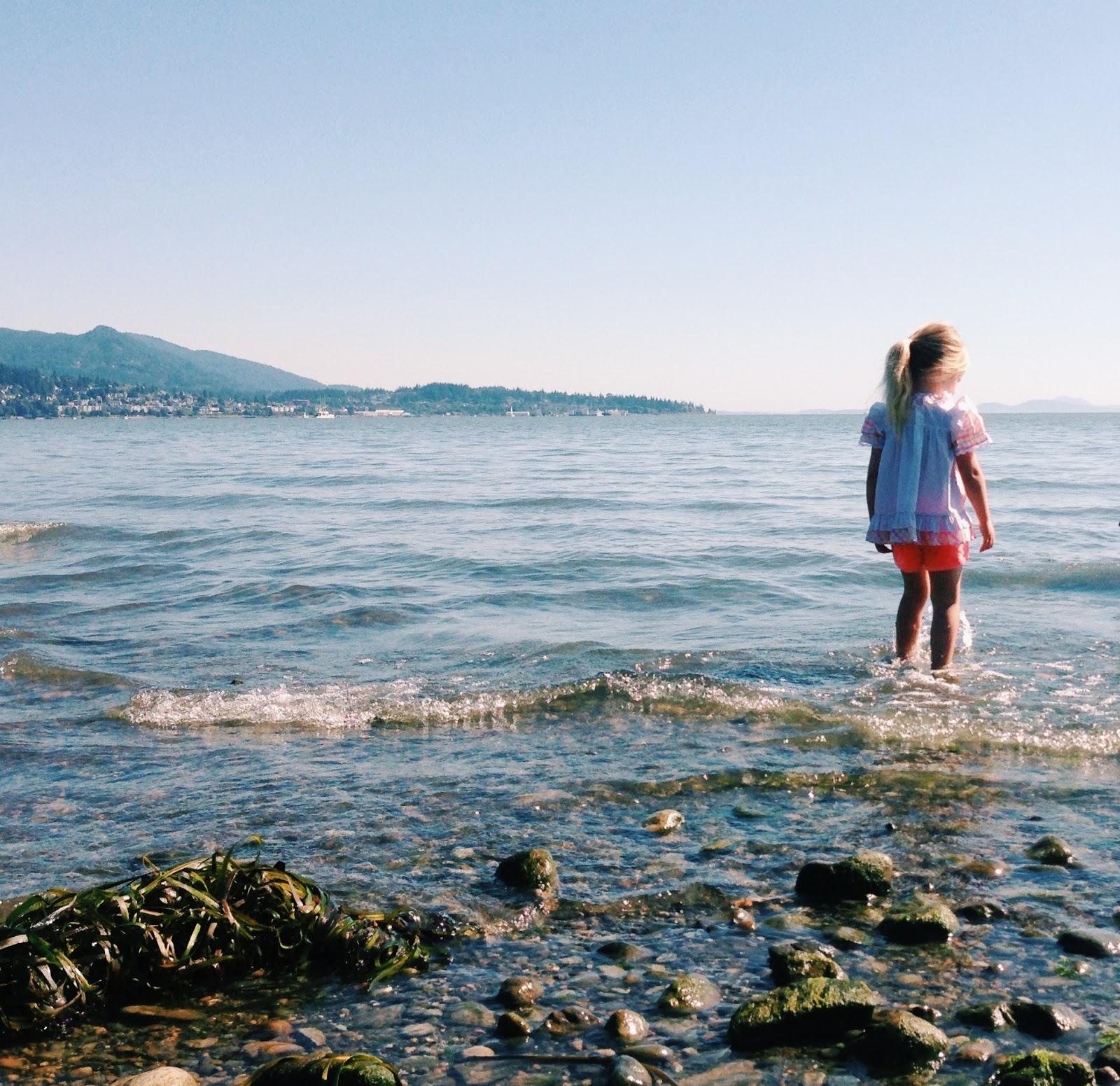
We're continuing our work with Puget Sound communities to reduce the amount of nutrients flowing through wastewater treatment plants and into the Sound. Our most significant action to reduce human sources of nutrients for 2021 is the development of the Nutrient General Permit for domestic wastewater treatment plants in Puget Sound.
Why control nutrients?
Nutrients are an important part of a healthy marine ecosystem, but excess nutrients cause too much algal growth, which ultimately depletes dissolved oxygen (DO) in the water. This algal growth occurs because nutrients are fertilizer for algae and aquatic plants. When these algae and plants die, their decomposition uses up oxygen. Many parts of Puget Sound and the Salish Sea have DO levels that fall below the concentrations needed for marine life to thrive. In addition to low levels of oxygen, effects of excess nutrients include:
- Increasing the acidity of the water
- Shifts in the food web
- Increases in harmful algal blooms and nuisance species like jellyfish
These issues are directly related to supporting a healthy ecosystem for salmon and orca recovery. Science tells us that excess nutrients from sewage treatment plants (domestic wastewater treatment plants, or WWTPs) are contributing to low oxygen levels in Puget Sound. Because of this, we must require treatment plants to control nutrients consistent with the federal Clean Water Act and Washington’s Water Pollution Control Act.
Most WWTPs in Puget Sound were not designed to remove nutrients such as nitrogen and will need upgrades to sufficiently control nutrients.
Understanding the informal draft permit
An early conceptual draft of the Puget Sound Nutrient General Permit is now available for public review and comment. This general permit applies to nearly 60 public domestic WWTPs that discharge directly to Puget Sound and its estuaries. All of the facilities already have individual National Pollutant Discharge Elimination System (NPDES) water quality permits that include a wide range of requirements to protect water quality. Only a few of these NPDES permits currently require nutrient controls. The new General Permit will focus only on controlling nutrients and work in conjunction with the broader individual permits for each facility.
The informal draft is conceptual and does not have as much detail as the formal draft and final permits will include. Given the complexities of this permit and the critical services sewage treatment plants provide, we are offering multiple opportunities for stakeholder input as we develop the permit.
The informal draft was prepared after working with our Advisory Committee, comprised of regional WWTP representatives, state agencies (including Ecology and Commerce), the U.S. Environmental Protection Agency, and the environmental community.
While some algae/jellyfish blooms and macroalgae littering the beaches happens naturally, our scientists are seeing increased number of events and more severe blooms than before.
The goal of the informal draft permit is to describe Ecology’s proposed requirements for the first permit term and provide context and explanation for how we used the conceptual approaches identified in the Advisory Committee's recommendation document.
The approaches include:
- Optimization of current treatment processes to enhance nutrient reduction
- Monitoring to evaluate nutrient reductions and get a consistent Sound-wide data set that can support a framework for future “water quality trading” among plants
- Nutrient Action Levels that will trigger additional required actions at some plants
- Initial planning for future plant upgrades, but not engineering design work unless plants trigger additional requirements
- Lesser requirements for plants already successfully implementing nutrient control technologies
We're not proposing to require major infrastructure investments in the first five-year permit. Depending on the current capabilities of each individual WWTP and their community’s plans for growth and development, they will have a reasonable amount of time to plan appropriate upgrades or other improvements, while remaining in compliance with their permits.
Our proposed adaptive management approach prevents further increases in excess nutrient loading in this first general permit. After additional modeling, we will propose nutrient limits in the second five-year general permit, continuing the path to compliance with water quality standards. Once we have limits, we will continue to work with permittees to develop a multiple year, stepwise process for attaining final limits.
We're asking for your feedback
We're asking for feedback on our proposed permitting approaches, especially where there are options available for which direction we should take on a specific permit condition. We'll consider all comments received during the informal comment period and use them in developing the formal draft permit.
Comment period from Jan. 27 to March 15
Please use our online comment form (ecomments) to submit comments. More information on how to comment on the informal draft is on the permit webpage.
As a way to provide additional information and answer questions, we're holding virtual information sessions:
- Tuesday, Feb. 9 at 9 a.m.
Join the webex - Wednesday, Feb. 10 at 5:30 p.m.
Join the webex
We anticipate issuing the formal draft general permit for public comment this spring and will hold public hearings during this time. We expect to make a final permit decision later in 2021, after reviewing public comment.
The cost of controlling nutrients
While the technology to control excess nutrients exists, addressing this type of pollution is a relatively new task for many WWTPs in Western Washington. Many communities will need to make infrastructure investments to reduce excess nutrients. Planning these investments will take time and there's significant cost associated with this work. In some cases, where existing facilities are located on limited land or have other constraints, communities will need to plan for more creative solutions. This is why efforts to reduce nutrients need to start now, before Puget Sound's health further declines.
As an agency, we're supporting this work through our traditional State Revolving Fund grant and loan program and a nutrient specific grant request during the 2021 legislative session. As part of Governor Inslee’s proposed 2021-2023 budget, the $9 million grant program will help provide financial assistance to facilities for nutrient reduction planning and optimization projects.
Members of the Advisory Committee’s environmental caucus and utility representatives have continued to meet to explore other strategies to secure additional funding, and we will support their proposals to the fullest extent that we can.
Addressing other sources of excess nutrients
Limiting nutrients from WWTPs will address Clean Water Act requirements and improve water quality. However, it will not completely solve Puget Sound’s low oxygen problem. We'll continue our work to reduce nutrients from other sources as well. The Salish Sea Model indicates that a comprehensive suite of measures, including reductions from non-point pollution sources in watersheds, are needed to fully achieve dissolved oxygen criteria in Puget Sound.
Our general permit work is in tandem with the Puget Sound Nutrient Reduction Project and Forum that will develop a Puget Sound Nutrient Reduction Plan. This plan will address reducing human sources of nutrients to Puget Sound from a variety of sources. We expect to complete a draft of this plan in late 2022 and we'll open a public comment period to receive feedback. A summary of the work completed with the forum and plans for 2021 are available in this 2020 year end message.
There are WWTPs in the Puget Sound Basin that are not under this general permit. The U.S. Environmental Protection Agency is the permitting authority for federal and tribal WWTPs, and they intend to incorporate nutrient controls into individual permits for each facility. Ecology will issue Clean Water Act Section 401 water quality certifications to ensure that the permits for these facilities meet state water quality standards.
In addition, there are nine privately owned and operated WWTPs that discharge into Puget Sound. Ecology will include nutrient controls in their individual permits during the reissuance process for each permit. Finally, for the WWTPs discharging to rivers upstream of Puget Sound, we currently plan to include those facilities in the second five-year general permit.
A healthier Puget Sound for everyone
Reducing nutrient pollution is an important step in protecting and restoring Puget Sound for all of those who use, need, and enjoy the sound in their daily life. A healthy Puget Sound provides critical resources — food and jobs — to a diverse range of people. WWTP upgrades are expensive and we are committed to working with communities to support funding, provide technical assistance, and phase-in compliance deadlines.
Puget Sound communities will continue to grow, adding more people and more nutrients into the system. Our proposed permitting approach supports smart growth — ensuring communities invest in wastewater infrastructure that protects Puget Sound and all it provides to people and the environment.
We look forward to hearing feedback on this early draft permit and to working with everyone to continue to find solutions for reducing nutrients and restoring Puget Sound.





